English Pickled Onions (Pub Style)
This post may contain affiliate links. See my disclosure policy.
Practically a British institution, it’s hard to imagine life in Great Britain without pub style pickled onions! Easy to make and irresistibly tasty, you’ll want to make a double batch while you’re at it!
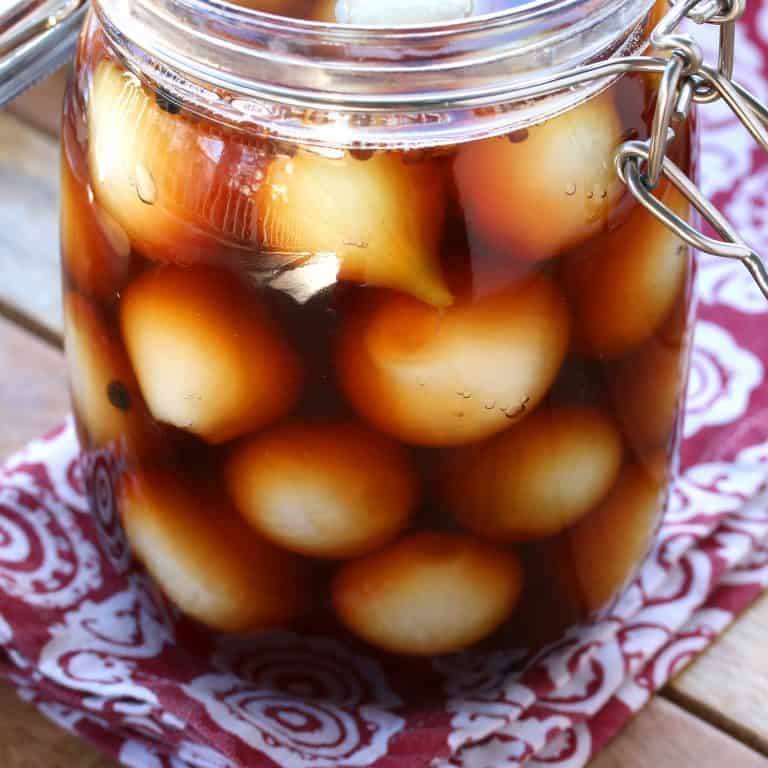
What are English Pickled Onions?
Right up there with fish and chips, mushy peas, bangers and mash, crumpets, toad in the hole and Yorkshire pudding, English Pickled Onions are practically a British institution. Whether eaten as part of a traditional Ploughman’s lunch, sliced on mature cheddar cheese sandwiches, burgers and baked potatoes (even in mashed potatoes), finely chopped up in a tangy salad dressing, cream cheese dip, potato or pasta salad, as a relish for hot dogs, or eaten straight out of the jar – they’re as tasty as they are versatile.
Also a traditional pub classic, something you used to see walking into at British pub is a dark jar of these pickled onions sitting on the counter at the bar, a popular snack during cocktail hour.
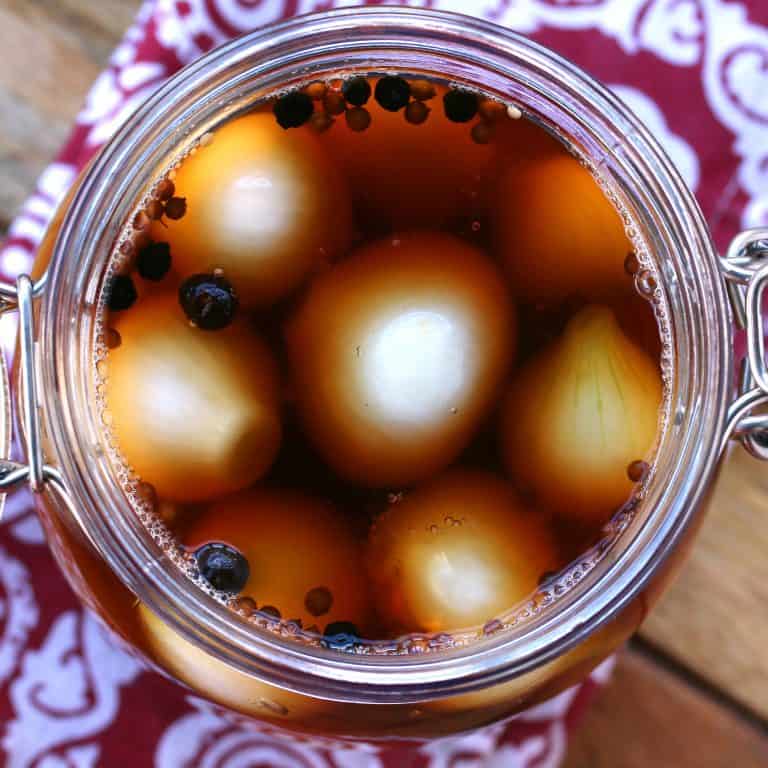
What really sets English Pickled Onions apart from other pickled onions is the use of malt vinegar as the brine base. Do not substitute with red wine vinegar, white vinegar, apple cider vinegar or any other vinegar. If it’s British pub-style pickled onions you’re after, malt vinegar is an absolute, non-negotiable must. And make sure it’s quality, real malt vinegar. It gives the brine its characteristic brown color and the onions’ famous sweet, tangy, caramelized flavor.

How to Make English Pickled Onions
English pub-style pickled onions are very easy to make but they require some patience. Where the patience comes in is peeling the small onions and then waiting for several weeks before eating them (a key to the best flavor). But we can assure you that the peeling and waiting pays off in the end.
Completely immersed in 5% vinegar, pickled onions keep for several months in the fridge. For those interested in canning them via the boiling water bath method for long-term storage I’ve provided those instructions, but know that there’s a significant tradeoff: They will store longer, yes. But they will also lose a lot of their “crunch”, which is a huge part of their enjoyability. For the best results simply pack the onions in jars and pour the hot vinegar over them; the heat from the vinegar is usually sufficient to create a vacuum as it cools seal the lids (a seal adequate for a few weeks’ storage at room temp during the maturation period while the flavors are developing). At the conclusion of the maturation period and once opened, store them in the fridge where they will keep for 3+ months.
If you ever tried these in the UK you’ll understand the love affair with pub-style English pickled onions. And if you want to make an ex-pat really happy, make them a gift of these homemade pickled onions, a taste of home. The store-bought ones in speciality British stores not only come with a hefty price tag, these homemade ones taste even better!
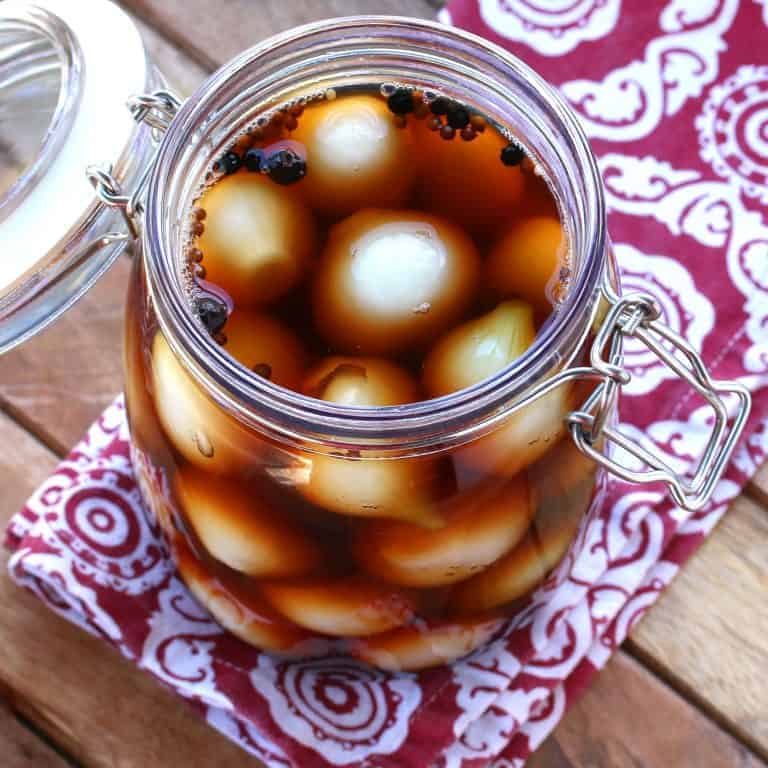
English Pickled Onions Recipe
Let’s get started!
To more easily peel the onions: Trim the ends off of each onion and place them in a heat-proof bowl. Pour boiling water over them and let them sit for a minute.
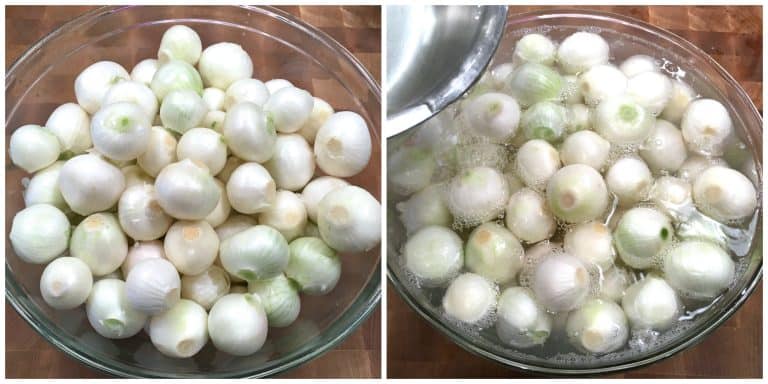
Then drain, rinse with cold water and remove the peels.
Place the peeled onions in a bowl, sprinkle with the salt and toss to distribute the salt. Cover with a towel or loosely with plastic wrap and let them sit at room temp overnight. Don’t let them sit longer than 14 hours or so or the amount of “crunch” will be compromised. Rinse well and drain thoroughly.

To make the brine: Place all remaining ingredients in a medium saucepan and bring to a boil until the sugar is dissolved.
While the brine is simmering, pack the onions into sterilized mason/Kilner jars. Pour the hot brine over the onions (I pour it through a sieve to collect the spices) and then distribute the spices among the jars. Stick a butter knife or other long object down into the jars to ensure there are no air bubbles. Wipe the jar rims down with a clean, damp cloth. Place the canning lids on the jars (or rubber rings if using) and screw/snap shut while hot to create a vacuum seal. Let the onions cool and then place them somewhere at room temp to mature for at least 3-4 weeks before eating, preferably 6-8 weeks for best flavor. Once opened store them in the fridge where they will keep for 3+ months.
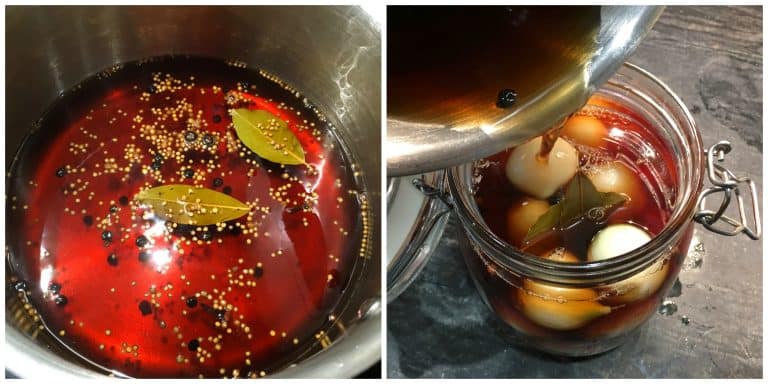
Canning Pickled Onions
These can be canned using the water bath method, but canning the pickled onions will mean losing much of the crunchiness of the onions. But if you want to can these for long-term storage, pack the onions into sterilized mason jars and pour the hot vinegar over them, distributing the spices in each jar (it’s easiest if you pour the brine into a sieve to collect the spices, then distribute them). Stick a butter knife or other long object down into the jars to ensure there are no air bubbles. Wipe the jar rims down with a clean, damp cloth.

Place the lids on the jars and screw them on. Process them in a boiling water bath canner. For pint-sized jars in altitudes up to 1000 ft, process for 10 minutes (see chart below for higher altitudes).
Remove the jars from the canner and let them sit undisturbed for 24 hours. Check to make sure the lids are airtight. Then store them in a cool, dark place where they will keep for up to a year. Once opened store them in the fridge where they will keep for 3+ months.
| Table 1. Recommended process time for Pickled Pearl Onions in a boiling-water canner. | ||||
| Process Time at Altitudes of | ||||
| Style of Pack | Jar Size | 0 – 1,000 ft | 1,001 – 6,000 ft | Above 6,000 ft |
| Hot | Pints | 10 min | 15 | 20 |
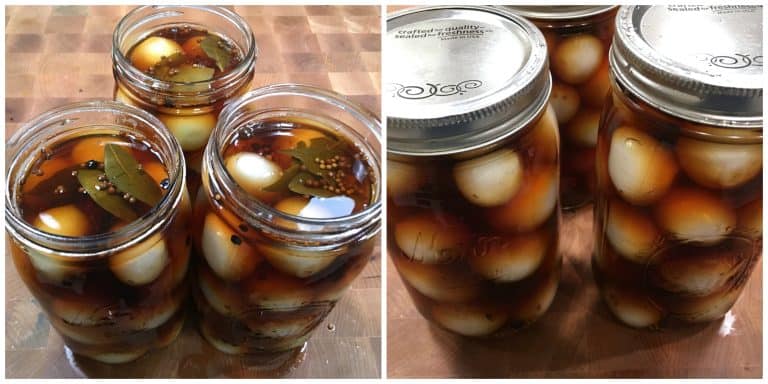
Enjoy!

For more pickled goodies be sure to try my:
- Pickled Banana Peppers
- Pickled Beets
- Pickled Carrots
- Giardiniera
- Pickled Jalapenos
- Pickled Pepperoncini Peppers
- Bread and Butter Pickles
- Pickled Turnips
- Pickled Asparagus
- Pickled Green Beans
- Pickled Okra
Save This Recipe
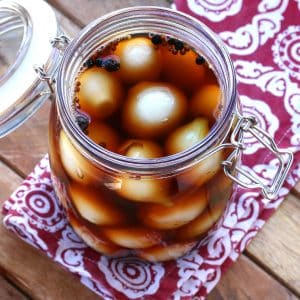
English Pickled Onions (Pub Style)
Ingredients
- 2 pounds small boiler onions (or larger pearl onions)
- 1 1/2 tablespoons salt
- 3 cups quality real malt vinegar
- 2 tablespoons honey
- 1/2 cup granulated sugar
- 1 teaspoon whole coriander seeds
- 1 teaspoon mustard seeds
- 1/2 teaspoon whole black peppercorns
- 2 allspice berries
- 2 whole cloves
- 2 bay leaves
Instructions
- To more easily peel the onions: Trim the ends off of each onion and place them in a heat-proof bowl. Pour boiling water over them and let them sit for a minute. Then drain, rinse with cold water and remove the peels. Place the peeled onions in a bowl, sprinkle with the salt and toss to distribute the salt. Cover with a towel or loosely with plastic wrap and let them sit at room temp overnight. Don’t let them sit longer than 14 hours or so or the amount of “crunch” will be compromised. Rinse well and drain thoroughly.
- To make the brine: Place all remaining ingredients in a medium saucepan and bring to a boil until the sugar is dissolved.
- While the brine is simmering, pack the onions into sterilized mason/Kilner jars (plan on using either 4 pint sized jars or 2 quart sized jars). Pour the hot brine over the onions (I pour it through a sieve to collect the spices) and then distribute the spices among the jars. Stick a butter knife or other long object down into the jars to ensure there are no air bubbles. Wipe the jar rims down with a clean, damp cloth. Place the canning lids on the jars (or rubber rings if using) and screw/snap shut while hot to create a vacuum seal. Let the onions cool and then place them somewhere at room temp to mature for at least 3-4 weeks before eating, preferably 6-8 weeks for best flavor. Once opened store them in the fridge where they will keep for 3+ months.
- If canning the onions via boiling water bath for long-term storage (note: they will lost much of their crunchiness): Pack the jars as described above and wipe the rims. Stick a butter knife or other long object down into the jars to ensure there are no air bubbles. Place the lids on the jars and screw them on. Process them in a boiling water bath canner. For pint-sized jars in altitudes up to 1000 ft, process for 10 minutes (see chart in blog post for higher altitudes).Remove the jars from the canner and let them sit undisturbed for 24 hours. Check to make sure the lids are airtight. Then store them in a cool, dark place where they will keep for up to a year. Once opened store them in the fridge where they will keep for 3+ months.
Notes
Nutrition
Originally published on The Daring Gourmet January 18, 2019



















This is a great recipe thank you. SO much better (and cheaper!) than supermarket ones. I buy my malt vinegar in 2 litre bottles which does four big (600ml) jars.
Thank you so much, Nikko!
Kimberly..step one… is it just salt or salt water…. most pickle recipies are brine soak… just want to clarify this..thanks
Hi Bedlam, the first step is to pour plain boiling water over them to loosen the skins so you can peel them. That’s followed by a sprinkling of salt and letting them sit for several hours which will extract the excess water from within the onions so that the brine you add later won’t be diluted. And then packing them in brine is the next step.
Just so you know, in Britain we don’t can pickled onions to make them shelf stable. Unlike a lot of US pickling recipes the vinegar is not diluted with water, it’s just pure vinegar. When you go to the pub they’re sitting on the shelf behind the bar, no need to refrigerate
Hi there, my recipe doesn’t dilute the vinegar with water, it’s pure vinegar. The canning option isn’t provided for the purpose of making them shelf stable, it’s provided for those who wish to preserve these very long-term, meaning a year or more.
I just found this recipe and want to try it. Is one bottle of the malt vinegar enough?
Hi Aynslie, most bottles are only 10-12 ounces and you need 24 ounces (3 cups). So depending on the size of bottle two of them should do the job.
Hi and thanks. Here in Florida, Pearl onions get expensive and white onions are usually huge.
I’ve been using the white ones but slice them into more or less 1/4s,pin them with toothpicks to pack into more into jars. I look leave the root area intact.
Works out pretty well.
Is there any use by date or best before date that I could go by?
Hi Jasper, these will keep for 3+ months.
This is the second time I have made them. Excellent flavour.
Both times I ran out of the pickling brine and had to make more.
I will make 1 and 1/3 next time.
FDA now allows hot water canning of pickled cucumbers at 180 degrees to preserve the crunch, would that work here?
I am English and have just pickled six jars.You do need dried chilli and ginger and they don’t need refrigeration.They keep for over 6 months .also I boil the mix and then cool it they stay crunchy and get hotter .yum.
Fabulous recipe. Perfectly crunchy onions after 8 hours in the salt with a really tasty brine
Wonderful, Connor, thanks so much!
Do I need to use Sugar and or Honey?.
Hi Brian, the honey and sugar help tame the harshness of the vinegar as well as contribute flavor. I definitely recommend adding them.
I followed this recipe exactly and ended up with jars of pickled onions that have no crunch whatsoever. Just a soft mess. We live at high altitude 3500ft, so I took that into account as well. It’s it possible to skip the soaking?
I soaked mine for 6 hours and got beautiful crunchy pickles the recipe is great the taste of the brine excellent.
Thank you, Jen, I’m happy they were a success and that you enjoyed them!
For good crunch you need to choose only rock hard onions to pickle. However, if slightly soft onions are all you can find you can brine them for a couple of days before pickling, which helps quite a lot:
Put onions into a bowl.
Toss in plain salt and water in the ratio of 1:4 salt:water by volume – eg 1c salt to 4c water, continue till onions are covered, stir with hand till salt is more or less dissolved.
Weight the onions down with a plate or similar.
Cover.
Change the salt/water brine after 24h if not pickling straight away.
Drain and wash the onions under running cold water.
Dry the onions.
Continue as per your recipe.
Anne, that sounds interesting. Doesn’t this give the same effect as if you had put them directly into a vinegar solution? Or am I asking the wrong question?
Julian, I believe that the salt absorbs some of the juices in the onion which leaves the onion more crunchy.
Eager to try this! How many jars (quarts or pints) do you need for this recipe?
Many thanks!
Hi Scott, plan on using either 4 pint sized jars or 2 quart sized jars. Happy pickling!
Is it 1 half tbs of salt or 1 and a half
Hi Darren, it’s 1 and a half.
Because I am a bit impatient I have my own way of making ‘pickled onions’. My mother used to make a fresh onion and cucumber salad with vinegar and sugar which I used to prefer rather than pickled onions. Instead of using whole onions I cut big onions in half so they are easier to slice and get a uniform thickness of 2 – 3 mm each, separate each slice, add vinegar, water and sugar to taste, I use one third water and two thirds vinegar and a cup of sugar for about 900 cc, it depends on how sweet you want it (not too healthy, but it the taste that counts!!) Store in jars or air tight containers. I leave the onions in the fridge for a couple of days and they are ready to eat, I use a similar method for pickled beetroot. They are both ideal for making sandwiches or used as side dishes.